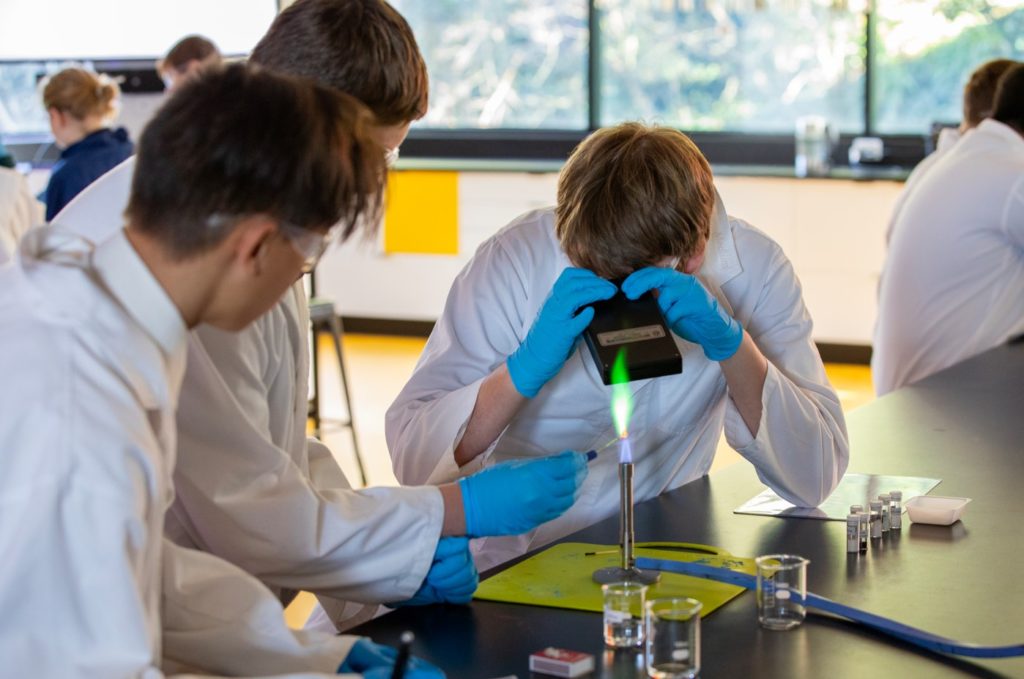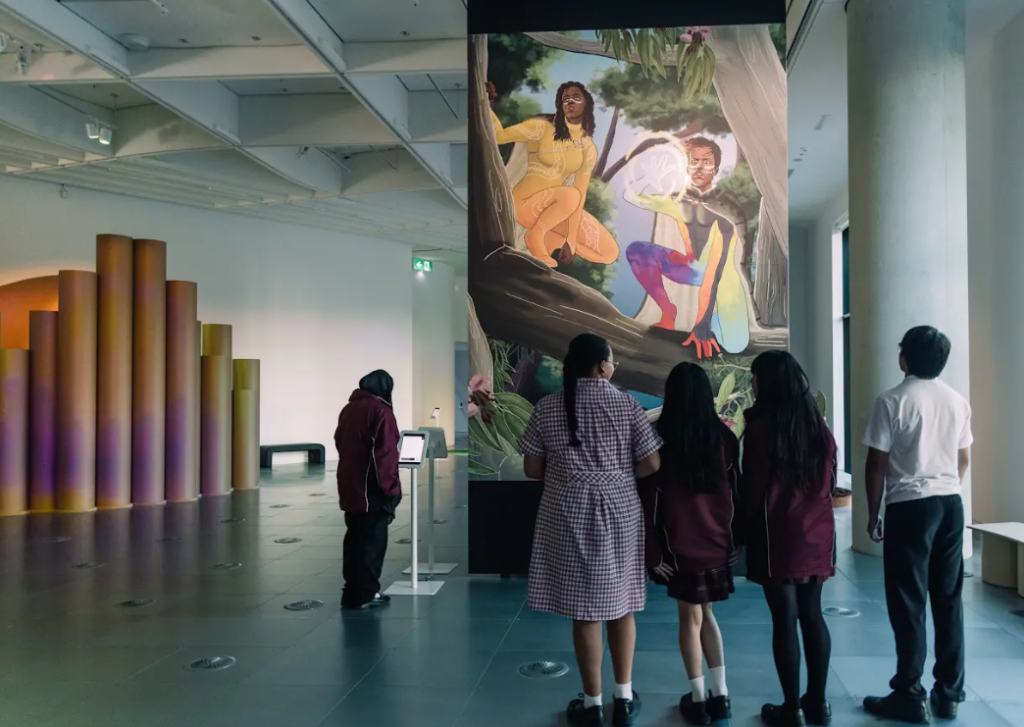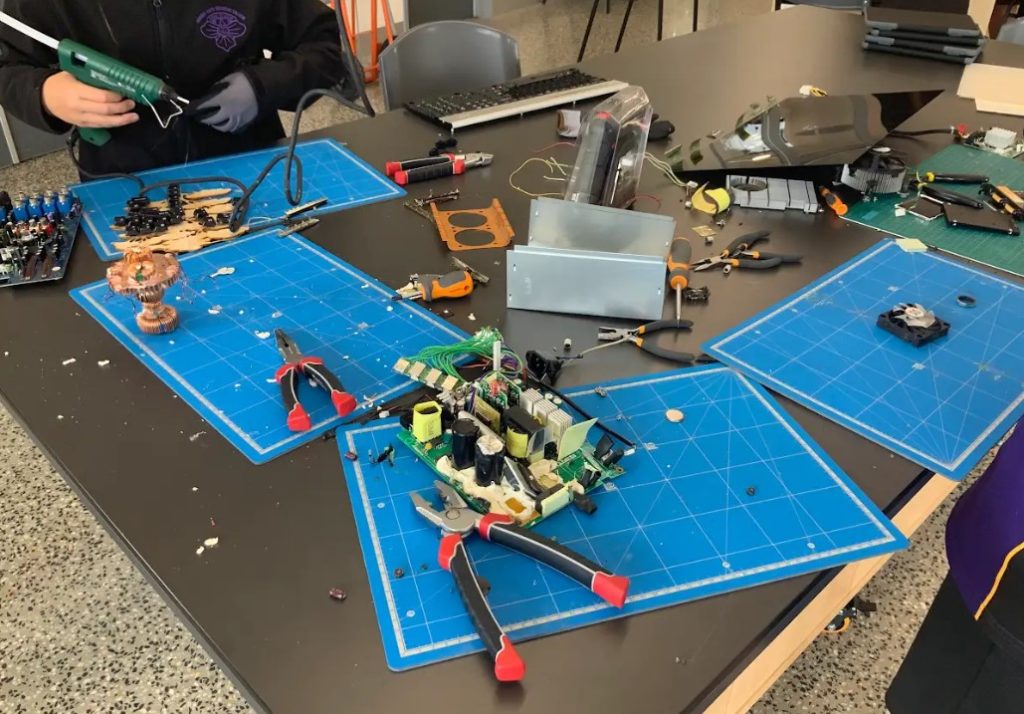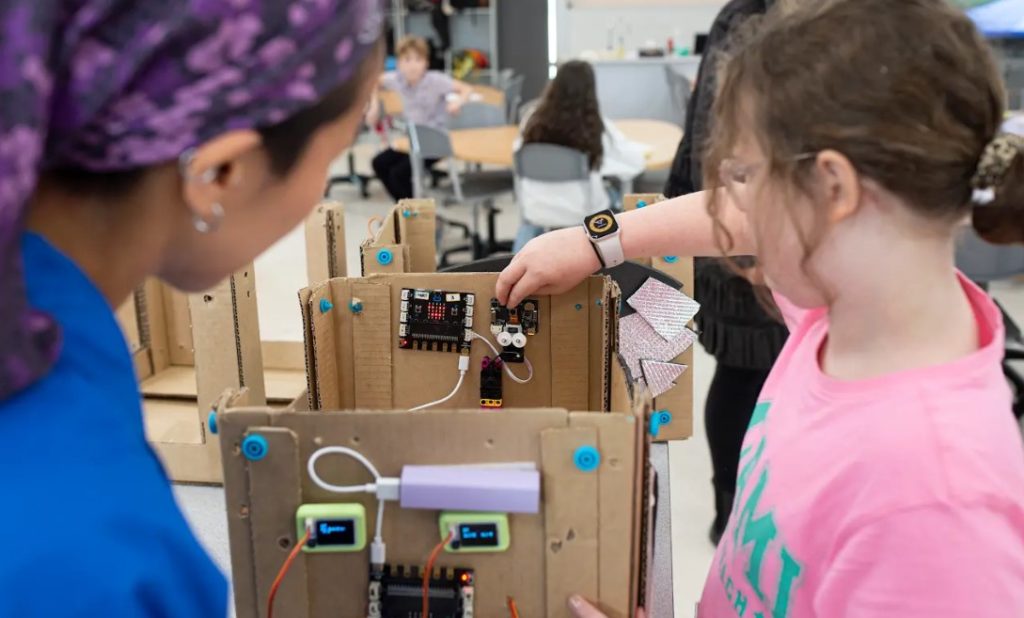STEM Around the State: Tech Schools & Specialist Centres
Scott Reddiex MRSV
Director of Engagement, The Royal Society of Victoria
Your experience with STEM topics at any school level can vary greatly across institutions, and the State of Victoria. The opportunities are uneven between remote, rural, regional, and metropolitan areas, and also between the different suburbs of Melbourne, where 75% of Victoria’s population resides. Additionally, within each of these regions, there is often a gap between the opportunities made available at public vs. private schools.
With teachers and schools possessing limited and uneven resources, and faced with an ever growing population to educate, it is vital that we support each student to have greater access to learning about STEM topics. This is for the benefit of the individual, their communities, and the workforce of the future.
Two initiatives that support Victorian students and teachers are the ten Tech Schools (with plans for six more), and six Science and Mathematics Specialist Centres, spread across the state.
The current iteration of Tech Schools are different to the tech schools of old. The current Tech Schools have a focus on building the skills of students in STEM areas, as well as with critical and creative thinking. Teachers bring groups of students to their nearest Tech School, where they work on real-world problems using things like robotics, virtual reality, and 3D printing.
The six Science and Mathematics Specialist Centres are more specialised learning centres, each focusing on a different topic area. They run programs for student groups both in-person and online, and are for all students from Prep to Year 12.
As part of this edition of Science Victoria on “STEMM Throughout Victoria”, we asked some of these Tech Schools and Specialist Centres for their thoughts and reflections on how these initiatives are going.
Our thanks to Ballarat Tech School, Science Gallery Melbourne, Gippsland Tech School, and the Gene Technology Access Centre (GTAC).
For more information on Tech Schools, visit vic.gov.au/tech-schools.
For Science and Mathematics Specialist Centres, visit schools.vic.gov.au/science-and-mathematics-specialist-centres.
————————————————
Ballarat Tech School
By Damon Minotti
Associate Director, Ballarat Tech School

Which school communities do you serve? How does your School/Centre seek to engage students?
The Ballarat Tech School partners all secondary and P-12 schools within the City of Ballarat Local Government area, but we also partner with Daylesford, Beaufort and Lake Bolac Colleges. In addition, we provide some program access on-site, virtually, and remotely, to schools from Ararat, Maryborough, Hamilton, Horsham, and the Wimmera.
We have a broad range of programs that aim to engage students in all STEM domains, offering a “Go Wide, Go Deep, Go Career” model that engages students at different complexities as they move through the year levels.
How do you support local teachers?
We try to work closely with teachers to tailor programs and Professional Learning to suit their unique situations, but it is an ongoing challenge to meet teachers at their point of need with their many time demands and a crowded curriculum. We have had more success when we can take a program or piece of technology to the school, provide initial training, and then leave it with them for a period of time.
To increase our reach, we also try to provide the opportunity to attend more general workshops, such as our upcoming collaborations with Earth Ed, Ecolinc, and the Regional Victorian Academy of Teaching and Leadership (VATL) co-hosting sessions on Artificial Intelligence.
We also have a focus on Pre-Service Teachers, in partnership with other Tech Schools, to help them hit the classrooms armed with knowledge and culture of familiarity and collaboration with Tech Schools from their first day of teaching.
What stands out as a success?
Without doubt, our flagship program is our Girls in STEM! It has transformed in different ways each year, and its current form brings together 60 students from up to 15 different schools to share in 2 days per term, 4 terms per year of networking, mentoring and exploration of different STEM themes and content. Each term is linked with a different industry experience or engagement and over the last 2 years, we have had alumni return as student leaders to help deliver the program in a relatable and meaningful way.
Along the journey we have recognised that while males still dominate the STEM workforce, there is declining interest and opportunity for them at a school level, so in 2024 we are running a Boys in STEM program in parallel with the girls using exactly the same format.
What were some unexpected challenges?
We are lucky to have a staff that are totally invested in providing the most meaningful, engaging and innovative learning experiences we can come up with as a team. Our structures afford us the luxury of prototyping and iterating our programs with much more regularity than you can in a traditional school environment, but that still takes time and intensive resources.
At times we have missed the mark in different ways, be it over investing in resources to deliver great levels of engagement but not quite hitting the curriculum outcomes we hoped for, or vice versa, but I’d say our biggest challenge continues to be narrowing down our ideas and programs under development to achievable numbers and timelines, especially those tied to grants and external funding.
What have you learned about the impact your School/Centre has on students and the broader community?
It can take years for the statistical impact of initiatives such as Tech Schools to become obviously measurable, however we believe that we do make a significant difference to the aspirations of our local and regional communities. Like anything in life we won’t reach and influence everyone, but for the many that do want to engage, whether they are young people and their families, members or industry or our community leaders, they all see the benefits of a modern learning environment with state of the art technology that not only develops work ready skills in STEM, but creates opportunities to make us all a little more world ready too.
In the regions that Federation University and TAFE operate with Tech Schools, we see ourselves as forerunners to their cooperative education model, as more and more industries see the value of engaging with young people during their education, not just afterwards. We have numerous examples of these connections inspiring career pathways into STEM that may not have been obvious or available before.
What do you think are the biggest challenges to engaging your local community in STEMM?
The world continues to evolve in complex and complicated ways. At times it can feel as though the divisions that exist in our regional, national and global communities can be simultaneously caused and potential solved by the same STEMM knowledge and applications, so as time, resources and the varied ways in which we interact and communicate with each become more competitive, ensuring that we are seen as a trusted, safe and accessible learning environment will be a critical element of our communities resilience and success.
————————
Science Gallery Melbourne
By Jesse Chambers (Deputy Head, Learning Programs) and Dr Vhairi Mackintosh (Learning & Outreach Manager),
Science Gallery Melbourne
Which school communities do you serve? How does your School/Centre seek to engage students?

Science Gallery Melbourne engages in deep partnerships with 25 local schools through the STEM Centre of Excellence, as well as over 200 schools from Victoria and beyond. Learning Experiences are interdisciplinary and showcase the relevance of STEM to all learning areas, including the arts.
How do you support local teachers?
Through the STEM Centre of Excellence, we co-design with partner schools to deliver programs that meet them at their point of need. Our learning experiences also provide teachers with a model of how to innovate with new and emerging Pedagogies.
What stands out as a success?
Our most successful initiatives are where we have co-designed with our partner schools and the outcome has resulted in schools embedding our content into their teaching and learning.
What were some unexpected challenges?
Some unexpected challenges have included balancing bespoke programming for diverse school settings with scalability.
What have you learned about the impact your School/Centre has on students and the broader community?
We have identified that our centre has enabled the university to reach audiences that they have not engaged with before, and provided a space for young people to showcase their learning with their own communities.
What do you think are the biggest challenges to engaging your local community in STEMM?
One of our biggest challenges is providing access to as many schools as possible who can benefit from our facilities and learning experiences. Another is justifying the value of informal learning for time-poor schools in a way that complements their learning at school.
————————
Gippsland Tech School
By Paul Boys
Director, Gippsland Tech School and Mobile Tech School
Which school communities do you serve? How does your School/Centre seek to engage students?
The Gippsland Tech School is hosted and managed by TAFE Gippsland, co-located at their Morwell Campus. The Tech School supports eighteen secondary schools in Latrobe City and South Gippsland Shire to attend the facility, where they work on STEAM learning programs aligned with curriculum from years 7 to VCE. We also have a Mobile Tech School, which supports 16 secondary schools across Wellington and east Gippsland shires.

How do you support the teachers in local schools?
Professional Learning programs are co-designed in partnership with Gippsland schools, and these range across a number of areas including design thinking, coding, robotics, innovation, and program design. We are fortunate to work with a number of passionate Gippsland teachers who work hard to provide their students with the best education and industry immersive experiences, to expose students to careers and pathways in their local communities.
What stands out as a success?
One of our most successful initiatives has been the implementation of our “A Renewable Future” program (gippslandtechschool.vic.edu.au/programs/renewable-energy/), which introduces students in years 7 and 8 to the advantages and disadvantages of the transition to renewable energy and the impacts on our climate and lifestyle needs. The program sees students work in teams to explore how renewable energy is created, stored, and distributed with specific reference to the economic and social considerations of the transition.
The program has evolved over the past 4 years to include hydrogen, battery storage and transmission to support students to see how industry is implementing new and emerging technologies in the roll-out of clean energy across Victoria.
What were some unexpected challenges?
One challenge that we have faced over the past 2 years has involved the roll-out of a Mobile Tech School, which works with Schools in Wellington and East Gippsland shires to facilitate STEAM programs in schools. The Mobile facility replicates programs which are based at our Morwell facility, and two team members travel to schools to facilitate programs as diverse as robotics, 3D design, sports science, physics, music, and film production.
We have worked hard to overcome the barrier of distance and equity to provide a regular service which sees the Mobile Tech School visit 14-16 schools each term with over 4,000 hours facilitated across 2023. The catchment area of the 2 LGA’s is equivalent to the size of Austria, with 1% of the population, and we are very proud of how we have worked to support communities across Gippsland to experience opportunities which are often unavailable to them.
What have you learned about the impact your School/Centre has on students and the broader community?
The best feedback that we receive from students and parents often occurs informally when we are in our local communities wearing our Tech School branded uniform. We regularly receive positive comments relating to how much students enjoyed their experiences at the Tech School. This is further validated by our industry partners who appreciate the co-design and collaborative experiences that they can share with students through Tech School curriculum.
What do you think are the biggest challenges to engaging your local community in STEMM?
Keeping STEAM relevant and engaging is an ongoing challenge for us as we support such a large geographic area which encompasses a significant number of communities which vary in their size and demographics. This is where local community partners including TAFE Gippsland, Federation University, LLENs (Local Learning and Employment Networks) and industry are critical to work collaboratively in support of young people in our region.
————————
Gene Technology Access Centre (GTAC)
By Jacinta Duncan and Dr Tony Chiovitti
Director and Deputy Director, GTAC
Which school communities do you serve? How does your School/Centre seek to engage students?
GTAC is a Science and Mathematics Specialist Centre located on the grounds of the University High School. Surrounded by the Melbourne Biomedical Precinct (Parkville) and collaborating with the nearby Walter and Eliza Hall Institute of Medical Research and the University of Melbourne, GTAC has a unique partnership between students, teachers and research scientists.
GTAC delivers STEM programs with a focus on the Life Sciences for 15,000 Victorian school students in levels 5 to 12 annually. We inspire students to pursue studies and careers in STEM by applying three central tenets. First, practising scientists collaborate with students to explore contemporary STEM. Second, students apply cutting edge technologies in their investigations. And third, our programs showcase innovative pedagogical approaches to delivering the Victorian STEM curriculum.
Students who attend GTAC programs have the opportunity to work closely with postgraduate students from research institutes across Melbourne as Scientist Mentors. Classes are divided into small groups (usually of around six) so that each student is able to be more hands-on with the activities, and can ask their Scientist Mentor questions about studying in high school, university, and the Mentor’s research. This provides students with a great chance to ask for advice and explore certain aspects of biology in greater depth. The Scientist Mentors also gain a lot from these sessions as they are encouraged to think outside the box as they adapt their teaching to different groups of students, and practise how they communicate about their own research and biology in general.
GTAC also has an impact on how teachers deliver curriculum in their schools through offering professional learning and a suite of online resources and students courses. The diversity of delivery modes in our programs, the connections with STEM research institutions and industry, the relational trust we have with schools across Victoria, and an agile education team are key to keeping GTAC at the forefront of STEM education in Victoria.
What stands out as a success? What were some unexpected challenges?

We continue to evolve to meet the needs of Victorian students, which is how we address the greatest challenge of ensuring that we remain up-to-date and impactful for students and teachers. A paradigm shift has led to using student voice to design programs that activate student agency. What does this look like? Students are resourced to direct their own learning supported by GTAC Education Officers and Scientist Mentors.
As part of a forensics program, Years 9 & 10 students are presented with evidence to solve an environmental crime. They decide on experiments to perform with the evidence they collect and use AI to interview suspects to solve the crime. In Tackling the Pollination Problem, Years 5 & 6 students select from a range of approaches, including emerging technologies, to design solutions to support bees to pollinate flowers.
In June this year, GTAC was the first educational setting in Australia to use Nanopore technology with students. 60 students participated in our annual four-day Science Immersion Research Experience program to gain insights into a career in biomedical research. They worked alongside veterinary scientists from the University of Melbourne to help identify parasitic cattle ticks by sequencing the DNA of microorganisms found on cattle as a step towards controlling cattle ticks. The data produced by students informed the collaborating scientists’ research.
What have you learned about the impact your School/Centre has on students and the broader community?
Over 20 years, a strength of GTAC has been our commitment to equity, prioritising access for students in the state’s most disadvantaged schools. In 2023, 15,737 students from 368 Victorian schools participated in GTAC onsite and outreach programs. Of these, 46% came from rural government schools and 30% from disadvantaged metropolitan government schools.
A new approach to outreach has been to develop STEM kits that we send to schools. They provide students with hands-on experiences using STEM technologies in their own classroom. Micro and Nano World Explorers is a STEM kit delivered through a collaboration with Inspire STEM Education. Schools are provided with imaging microscopes, including a scanning electron microscope, that they use to carry out an inquiry investigation of their choice.
What do you think are the biggest challenges to engaging your local community in STEMM?
It is becoming increasingly difficult for students to come to the Centre due to teacher shortages and costs of transport. Our new approach to outreach has been to develop STEM kits that we send to schools. These kits provide students with hands-on experiences using STEM technologies (including a scanning electron microscope and other microscopes) in their own classroom to carry out an inquiry investigation of their choice.
GTAC also sends teams of Education Officers and Scientist Mentors to regional locations across Victoria (e.g. Mildura and Daylesford). The team runs different programs for multiple year levels at different schools in the area over several days, often travelling to multiple locations in a day to have as great a reach as possible.






